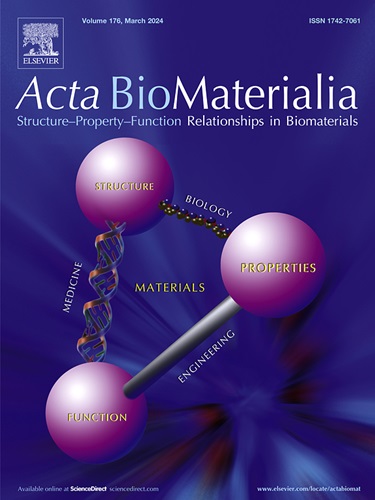中性粒细胞样细胞膜包覆的钼基纳米团簇减少脑出血后氧化应激和促进神经恢复。
IF 9.4
1区 医学
Q1 ENGINEERING, BIOMEDICAL
引用次数: 0
摘要
过多的活性氧(ROS)对大脑有害,可导致脑出血(ICH)后神经功能损伤和抑制神经功能恢复。然而,对于脑出血仍然缺乏有效的治疗方法,无论是药物还是神经外科手术。纳米酶具有优异的超氧化物歧化酶和过氧化氢酶特性,可以清除活性氧,可能为脑出血患者提供治疗机会。然而,纳米酶非侵入性靶向脑出血病变的能力和进一步的抗氧化作用仍不清楚。本文开发了中性粒细胞膜伪装的钼基多金属氧酸纳米酶(POM@Mem)来缓解ICH后的氧化应激。中性粒细胞膜包膜使POM能够靶向出血部位,进一步抑制ROS的产生。POM@Mem可改善脑出血小鼠神经炎症微环境,促进行为改善。结合中性粒细胞膜和纳米酶靶向脑出血部位为脑出血治疗提供了一种有效的策略。意义声明:过多的活性氧(ROS)对大脑有害,可导致神经功能损伤,阻碍脑出血(ICH)后神经功能的恢复。尽管如此,脑出血的有效治疗方法,无论是药物还是神经外科手术,仍然很少。在这项研究中,我们开发了中性粒细胞膜伪装的钼基多金属氧酸盐纳米酶(POM@Mem),作为缓解ICH后氧化应激的新方法。中性粒细胞膜涂层使POM纳米酶能够特异性靶向出血部位,从而抑制ROS的产生。此外,POM@Mem改善了脑出血小鼠的神经炎症微环境,促进了行为恢复。结合中性粒细胞膜和纳米酶靶向递送到脑出血部位为脑出血治疗提供了一个有希望的策略。本文章由计算机程序翻译,如有差异,请以英文原文为准。
Neutrophil-like cell membrane-coated molybdenum-based nanoclusters for reduced oxidative stress and enhanced neurological recovery after intracerebral hemorrhage
Excessive reactive oxygen species (ROS) are detrimental to the brain that can result in neurological impairment and inhibiting neurological functionals recovery after intracerebral hemorrhage (ICH). However, there is still a lack of effective treatment for ICH, either with medicine or neurosurgery. Nanozymes with excellent superoxide dismutase and catalase properties can scavenge ROS and may provide therapeutic opportunities for ICH patients. However, the ability of nanozymes to non-invasively target cerebral hemorrhage lesions and further antioxidation effect are still unknown. Herein, neutrophile membrane-disguised molybdenum-based polyoxometalate nanozymes (POM@Mem) were developed to alleviate oxidative stress after ICH. Coating with neutrophil membrane allowed POM to target the hemorrhage sites and further inhibit ROS generation. POM@Mem can improve neuroinflammatory microenvironment and promote behavioral improvement of ICH mouse. Combining neutrophile membrane and nanozymes for targeting brain hemorrhage sites provides an effective strategy for the treatment of ICH.
Statement of significance
Excessive reactive oxygen species (ROS) are detrimental to the brain and can lead to neurological impairment, hindering the recovery of neurological functions after intracerebral hemorrhage (ICH). Despite this, effective treatments for ICH, whether pharmaceuticals or neurosurgery, remain scarce. In this study, we developed neutrophil membrane-disguised molybdenum-based polyoxometalate nanozymes (POM@Mem) as a novel approach to alleviate oxidative stress following ICH. The neutrophil membrane coating enabled the POM nanozymes to specifically target hemorrhagic sites, thereby inhibiting ROS production. Additionally, POM@Mem improved the neuroinflammatory microenvironment and facilitated behavioral recovery in ICH mice. The combination of neutrophil membranes and nanozymes for targeted delivery to brain hemorrhage sites offers a promising strategy for the treatment of ICH.
求助全文
通过发布文献求助,成功后即可免费获取论文全文。
去求助
来源期刊

Acta Biomaterialia
工程技术-材料科学:生物材料
CiteScore
16.80
自引率
3.10%
发文量
776
审稿时长
30 days
期刊介绍:
Acta Biomaterialia is a monthly peer-reviewed scientific journal published by Elsevier. The journal was established in January 2005. The editor-in-chief is W.R. Wagner (University of Pittsburgh). The journal covers research in biomaterials science, including the interrelationship of biomaterial structure and function from macroscale to nanoscale. Topical coverage includes biomedical and biocompatible materials.
 求助内容:
求助内容: 应助结果提醒方式:
应助结果提醒方式:


